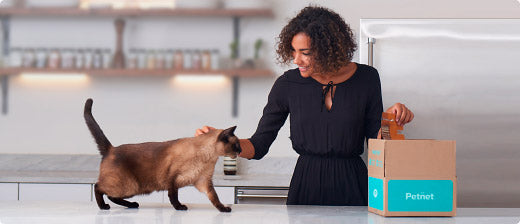Pet food labels can be really confusing. With all of the government regulations you would think that it would be as easy as reading a human food label, but it isn’t. How can you choose a good food for your pet? This post is the first of 2 posts that will break down those confusing pet food labels.
What information is on Pet Food Labels?
Two main authorities reign over pet food labels and production. Those authorities are the Food and Drug Administration and the Association of American Feed Control Officials (AAFCO). State governments also have a say in what they require in pet foods, but most of them just go with the rules set forth by the two former authorities. There are 6 parts of pet food labels that give you valuable information about the contents of the food: :) The Name
Besides the Brand name of the food (Friskies, Meow Mix, Wellness, etc), each different variety of pet food has a name like “Chicken Dinner with Gravy.” It is this second name that you really need to pay attention to when you read pet food labels. The details are in the section below.
The Ingredient List
By law all pet food labels must have a complete list of ingredients using the common name of the ingredient. More information on this will come in Part 2 of this series.
Guaranteed Analysis
This section of a pet food label gives you the guaranteed minimum percentage of crude fat and crude protein as well as the maximum percentage of fiber and moisture. Don’t be scared by the terminology – the term “crude” refers to the method of testing used to measure these quantities rather than the food itself. More information on this will come in Part 2 of this series.
Nutritional Adequacy Statement
This is a statement required by law to prove that a pet food that claims to be “complete and balanced” has met the standards that show it can be a source of everyday nutrition. It will usually say something like “”(Name of product) is formulated to meet the nutritional levels established by the AAFCO (Dog/Cat) Food Nutrient Profiles.” More information on this will come in Part 2 of this series.
Feeding Directions
This is where the pet food company gives a general idea of how much a cat or dog would typically need to be fed of this food. Feeding directions are more of a guideline than a rule – always confer with your veterinarian about your pet’s nutritional needs.
Calorie Statement
Just like in human food, pet food labels must list the amount of calories in the food. The law requires that these labels are listed in kilocalories (kCal) per kilogram. A kilocalorie is the same measurement you are used to thinking of as a calorie.
What the name of the food says about its contents
Pet food names are really sneaky. They seem very innocent until you realize how a slight change in the wording can mean a huge difference in the contents of the food. The law regulates the amount of an ingredient that must be in a pet food with a certain type of name. Pet food companies know about these laws and use them to their full advantage.
The “95%” Rule
A pet food with an ingredient (Rabbit) that would fall under the 95% rule.
Whenever pet food labels have straight forward names like “Chicken Cat Food” or “Salmon Food for Cats”, the food must be 95% whatever ingredient is listed. So the example of “Chicken Cat Food” would have to be 95% chicken. Of course this means that the listed ingredient would have to be the first ingredient on the list of ingredients.
If there are 2 ingredients listed on the label such as “Chicken and Salmon Cat Food” then those two ingredients combined must be 95% of the food. The ingredients must also be listed in the order of which ingredient there is more of in the food. In the “Chicken and Salmon Cat Food” example, there would be more Chicken than Salmon, but the total of the Chicken and Salmon would be 95% of the food.
The 95% rule only counts for meat, poultry, and fish ingredients. If a label were to say “Chicken and Rice Cat Food,” then it would still have to be 95% Chicken. The rice would not count as part of the 95%.
The “25%” Rule or the “Dinner” Rule
Here’s where things start to get tricky. A pet food company only has to make a pet food be 25% made of a named ingredient by placing words like “Dinner,””Entree,” “Platter,” “Nuggets,” or “Formula” in the name of the food. That means that while a “Chicken Cat Food” is 95% chicken, a “Chicken Entree for Cats” only needs to have 25% chicken. That little wording change could bump the main ingredient from first on the ingredients list down to third or fourth.
Much like with the 95% rule, if there are 2 ingredients listed in the name of the food, then those to ingredients combined must be at least 25% of the food. That means that “Chicken and Salmon Entree for Cats” would have to to be a total of 25% chicken and salmon. The ingredient there is most of must go first in the name again.
This time any ingredient listed in the title is a part of the 25% whether is is animal product or not. A food labeled “Chicken and Rice Entree for Cats” would be a minimum total of 25% chicken and rice (yes the chicken in this case would likely be less than 25%). Of course, the ingredient that there is more of would have to go first in the name, so in this case there would be more chicken than rice.
The “3%” Rule or “With” Rule
A pet food label that uses “with.” “With Chicken Pate & Diced Duck”
When the name on pet food labels uses “with” in the name, the named ingredient only has to make up 3% of the food. That means that a pet food called “Cat Food with Chicken” only has to contain 3% chicken. That could mean that the ingredient you thought was the main ingredient is really way down on the list!
The “Flavor” Rule
Any time you see the word “Flavor” in the name of a pet food, there is only require to be a detectable amount of that named ingredient. These foods may not even contain the actual ingredient on the label. “Chicken Flavored Cat Food” may only have chicken broth in the ingredients. A “Milk Flavored” food or treat may only contain whey to get the milky flavor.

 Food
Food
 Food
Food
 Food
Food
